Beach Ball –Summer Fun
Although a Californian gentleman has been credited with the invention of the beach ball, and many of our earlier versions were made from rubber and imported from England, it’s pretty accurate to state that people have been playing with balls, on beaches, a lot longer then the 1938 date ascribed to the Jonathon DeLonge. One of the earliest records of playing, what looks like an early version of volleyball, occurs in WA in 1927:
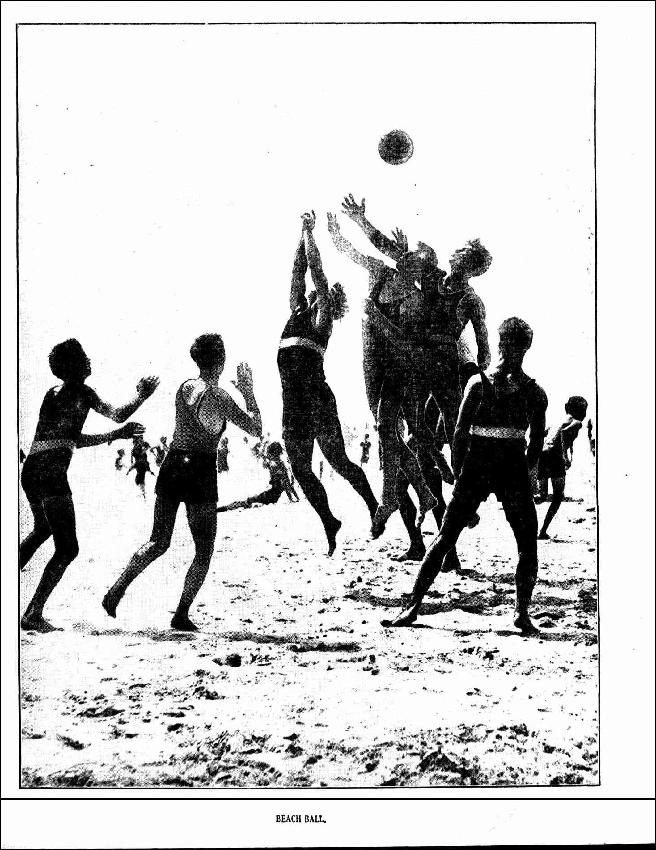 BEACH BALL. (Picture to right): BEACH BALL. (1927, February 24). Western Mail (Perth, WA : 1885 - 1954), p. 5. Retrieved fromhttp://nla.gov.au/nla.news-article38006419
BEACH BALL. (Picture to right): BEACH BALL. (1927, February 24). Western Mail (Perth, WA : 1885 - 1954), p. 5. Retrieved fromhttp://nla.gov.au/nla.news-article38006419
When researching where the ever popular and now oversized fun for the sun and sand ‘beach ball’ first appeared we first had to ignore all those other ‘beach balls’ that occurred in Australia from the turn of the century up until the second world war, which were all about donning a ball gown and waltzing around a room to music that thrills the soul:
Ball at Manly Beach.- On Friday evening, May 18, a ball was held in the Oddfellows' Hall, Manly, under the auspices of the Operative Stonemasons of Manly. The hall was gaily decorated with flags and evergreens, tastefully arranged. The catering elicited much praise for the munificent supply and the artistic taste displayed in the table arrangement, ably carried out by Mr. and Mrs. Wm. Johnson, of Manly. An efficient band supplied by Mr. H. Ingram, of the Arcade, Sydney. About 30 couples met to enjoy the pleasures of the evening. The ladies being much admired for the elegance and taste displayed in dress. The event was ably presided over by Messrs. Melwain, Grant, and Cowell. Dancing was kept up until the small hours of morning, when, after singing the National Anthem, the company dispersed to their homes unanimously declaring the event to be a decided success. Ball at Manly Beach. (1883, May 23). Evening News (Sydney, NSW : 1869 - 1931), p. 6. Retrieved fromhttp://nla.gov.au/nla.news-article111029752
The first known use of the word ball in English in the sense of a globular body that is played with was in 1205 in Laȝamon's Brut, or Chronicle of Britain in the phrase, "Summe heo driuen balles wide ȝeond Þa feldes." The word came from the Middle English bal (inflected as ball-e, -es, in turn from Old Norse böllr (pronounced [bɔlːr]; compare Old Swedish baller, and Swedish boll) from Proto-Germanic ballu-z, (whence probably Middle High German bal, ball-es, Middle Dutch bal), a cognate with Old High German ballo, pallo, Middle High German balle from Proto-Germanic *ballon (weak masculine), and Old High German ballâ, pallâ, Middle High German balle, Proto-Germanic *ballôn (weak feminine). No Old English representative of any of these is known. (The answering forms in Old English would have been beallu, -a, -e—compare bealluc, ballock.) If ball- was native in Germanic, it may have been a cognate with the Latin foll-is in sense of a "thing blown up or inflated." In the later Middle English spelling balle the word coincided graphically with the French balle "ball" and "bale" which has hence been erroneously assumed to be its source. French balle (but not boule) is assumed to be of Germanic origin, itself, however. In Ancient Greek the word πάλλα (palla) for "ball" is attested besides the word "σφαίρα", sphere. Ball. (2013, October 12). In Wikipedia, The Free Encyclopedia. Retrieved from http://en.wikipedia.org/w/index.php?title=Ball&oldid=576906031
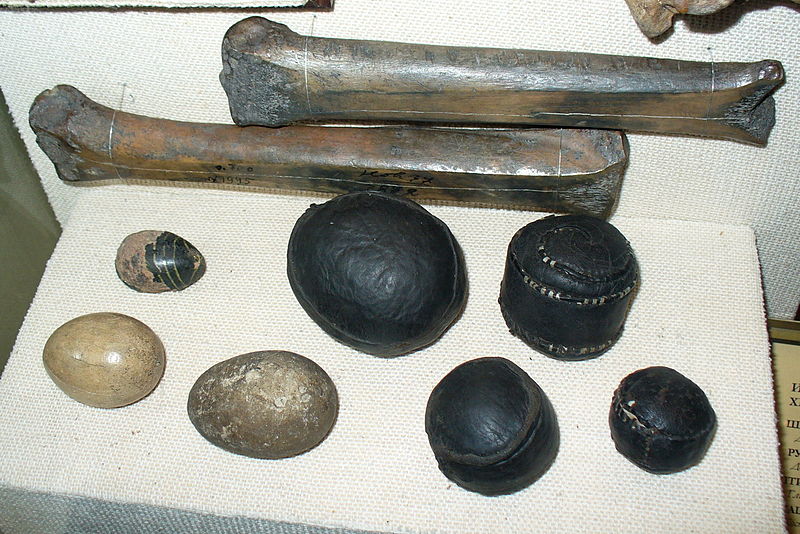
Russian leather balls (Russian: мячи), 12th-13th century.
The first plastic made from bright panels versions began to be massed produced in the early 1950’s although advertised for sale in Australia much earlier then this. The shift from rubber to plastic is actually a lot older then you may suppose with archaeologists stating in 1600 BC, Mesoamericans used natural rubber for balls, bands, and figurines. Many beach balls are made from PVC or Poly(vinyl chloride), commonly abbreviated PVC, the third-most widely produced plastic, after polyethylene and polypropylene.
PVC can be made softer and more flexible by the addition of plasticizers, the most widely used being phthalates. In this form, it is also used in clothing and upholstery, electrical cable insulation, inflatable products and many applications in which it replaces rubber. PVC was accidentally discovered at least twice in the 19th century, first in 1835 by French chemistHenri Victor Regnault and then in 1872 by German chemist Eugen Baumann. On both occasions the polymer appeared as a white solid inside flasks of vinyl chloride that had been left exposed to sunlight. In the early 20th century the Russian chemist Ivan Ostromislensky and Fritz Klatte of the German chemical company Griesheim-Elektron both attempted to use PVC in commercial products, but difficulties in processing the rigid, sometimes brittle polymer blocked their efforts. Waldo Semonand the B.F. Goodrich Company developed a method in 1926 to plasticize PVC by blending it with various additives. The result was a more flexible and more easily processed material that soon achieved widespread commercial use. Polyvinyl chloride. (2013, December 29). In Wikipedia, The Free Encyclopedia. Retrieved from http://en.wikipedia.org/w/index.php?title=Polyvinyl_chloride&oldid=588248702
For The Beach Grown-ups as well as youngsters who are going to the seaside for the holidays may purchase colored swimming belts which can be inflated, and beachballs' in many colors. Sailing boats and yachts, and all sorts of beach equipment are specialties.FAIRYLAND FOR CHILDREN. (1932, December 13). The Advertiser (Adelaide, SA : 1931 - 1954), p. 18. Retrieved fromhttp://nla.gov.au/nla.news-article73994932
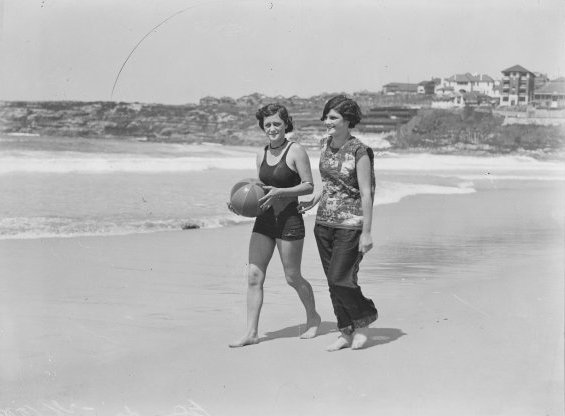
Two Bondi Beach belles walking along the waters edge with a sports ball, Sydney, 28 October 1930 . Pic No: nla.pic-vn6266886, Part of Fairfax archive of glass plate negatives [picture] between 1890 and 1948. Courtesy National Library of Australia.
TOY LINES AT THE STAR. Bucket and wooden spade complete,2/6. Inflatable beach balls, 9/11ea Metal spades 1/ and 2/6 ea. Metal puzzles 2/11. Plastic sleeper dolls, 6in., with movable arms andlegs. 3/11 ea. Cnr.. Hay and King sts., Perth. Advertising. (1950, December 19). The West Australian (Perth, WA : 1879 - 1954), p. 25. Retrieved from http://nla.gov.au/nla.news-article48142172
Once again the beginnings of ‘volleyball’, already being played in the States as early as 1922, are described as various forms of ‘beach tennis’;
WOMAN'S REALM and SOCIAL NEWS MORE HOUSE PARTIES AT LORNE Medicine Ball Played on Beach (By Our Special Representative) LORNE Sunday-The season at Lorne is by no means closed after the Christmas and New Year festivities are over and many of those who come regularly to this popular resort year after year prefer to leave their holidays until later. The days are still warm enough for swimming and sun baking until after February and Lorne has other attractions to offer when the weather becomes cooler01 on the occasional odd daj In the middle of summer when a brisk walk gives more pleasure than a dip in the sea. Tennis fishing and riding all have their devotees and there is also a kind of beach tennis played with a huge gaily coloured medicine ball on an abbreviated court marked on the sand. WOMAN'S REALM and SOCIAL NEWS. (1934, December 31).The Argus (Melbourne, Vic. : 1848 - 1957), p. 12. Retrieved from http://nla.gov.au/nla.news-article11004261
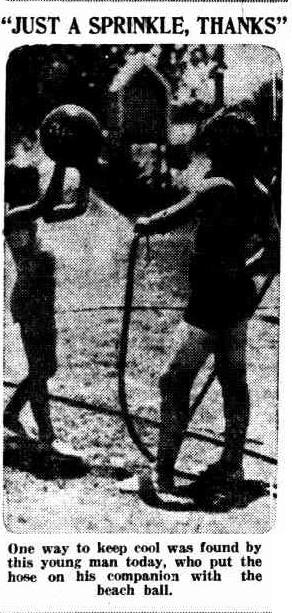 FOOTER TENNIS. Mark out a court on the beach about 40ft. by 20ft., and across the middle of it stretch a rope about breast high, securing it to two poles. A player stands each side of the “net." The server first bounces a large Inflated bladder or beach ball, and 'then kicks it over, the net Into the opponent's court. The receiver then endeavours to return the ball by either kicking it or heading it. The service Is taken in turns, and points are lost when the ball goes out of court or is not returned on the volley or after it has bounced once. The player who is the first to-losesIx points loses the game. Each player takes it in turn to play all the others, and the one with the most wins to his credit is the winner of the tournament. FOOTER TENNIS. (1935, December 11). Examiner(Launceston, Tas. : 1900 - 1954), p. 16 Edition: DAILY, Supplement: The Examiner WOMEN'S SUPPLEMENT. Retrieved from http://nla.gov.au/nla.news-article51967300
FOOTER TENNIS. Mark out a court on the beach about 40ft. by 20ft., and across the middle of it stretch a rope about breast high, securing it to two poles. A player stands each side of the “net." The server first bounces a large Inflated bladder or beach ball, and 'then kicks it over, the net Into the opponent's court. The receiver then endeavours to return the ball by either kicking it or heading it. The service Is taken in turns, and points are lost when the ball goes out of court or is not returned on the volley or after it has bounced once. The player who is the first to-losesIx points loses the game. Each player takes it in turn to play all the others, and the one with the most wins to his credit is the winner of the tournament. FOOTER TENNIS. (1935, December 11). Examiner(Launceston, Tas. : 1900 - 1954), p. 16 Edition: DAILY, Supplement: The Examiner WOMEN'S SUPPLEMENT. Retrieved from http://nla.gov.au/nla.news-article51967300
The inflatable version being used as a device for fun in the water as much as on the sand, was causing a few problems for youngsters. The 'Boy Drifts with Beach Ball' article below was reported in every major newspaper throughout Australia:
A Beach Ball Warning. Huge rubber halls for youngsters on the shore and in the water are highly popular this season, as also monster fish of unknown species, and other strange creatures unknown to the zoo. These are diverting, and the children are naturally very fond of them, but a word of warning. One or two Incidents on the beaches during the last few days indicate that parents will do well to keep an observant eye on children playing in the water with these inflatable contrivances. Being full of air and very light, a puff of wind and a receding tides will quickly carry them sea-wards, followed by the unwary owner, who may find themselves out of their depth. For the swimmers it does not matter much, but fox the little one who cannot swim there is the possibility of grave results. A little extra care and observation by parents or guardians, and a few words of warning to the youngsters, may be the means of averting tragedy.A Beach Ball Warning. (1933, January 4). The Mercury (Hobart, Tas. : 1860 - 1954), p. 6. Retrieved from http://nla.gov.au/nla.news-article24715083
JUST A SPRINKLE, THANKS. One way to keep cool was found by this young man today, who put the hose on his companion with the beach ball. "JUST A SPRINKLE, THANKS". (1933, January 6). The Daily News (Perth, WA : 1882 - 1950), p. 5 Edition: HOME EDITION. Retrieved from http://nla.gov.au/nla.news-article83917126
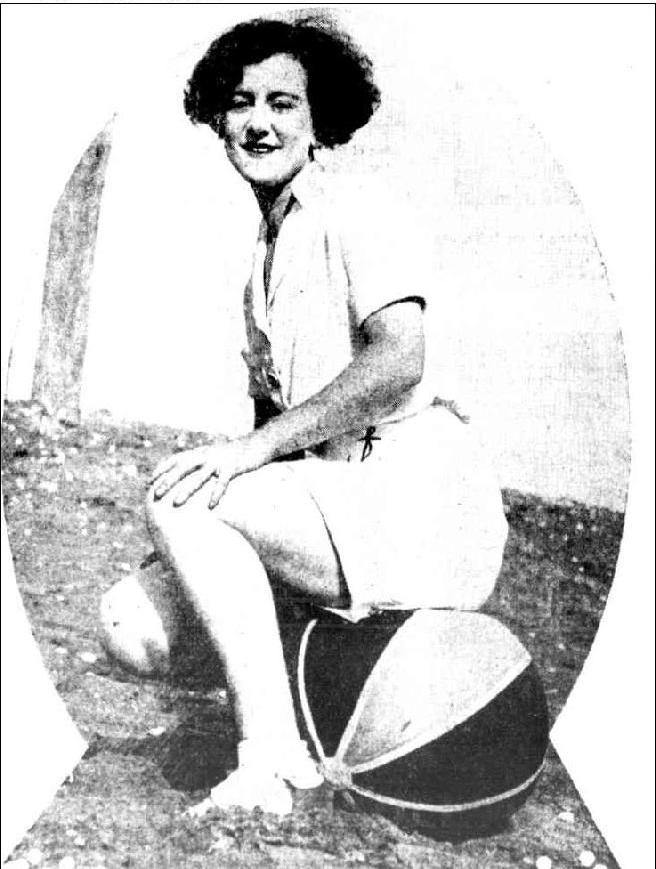 BOY DRIFTS WITH BEACH BALL Rescuer in Difficulties ADELAIDE. December 28. Kevin Frederick Golding, of Prospect, floated out to sea on a beach ball 100yards from the shore at Camp Reserve, Victor Harbour, to-day. Then he lost his grip of the ball and sank in 18ft. of water. Geoffrey Ramsford(19), of Norwood, swam out and grasped the boy, but he got into difficulties in a hard fight to bring the boy ashore in the choppy sea Harry Goodenough, of Walker, dashed into the water in his clothes to assist the rescuer, who had nearly collapsed. Rainsford and Golding were exhausted when land was reached, but they soon recovered. BOY DRIFTS WITH BEACH BALL. (1933, December 29). The Courier-Mail (Brisbane, Qld. : 1933 - 1954), p. 10. Retrieved fromhttp://nla.gov.au/nla.news-article1155330
BOY DRIFTS WITH BEACH BALL Rescuer in Difficulties ADELAIDE. December 28. Kevin Frederick Golding, of Prospect, floated out to sea on a beach ball 100yards from the shore at Camp Reserve, Victor Harbour, to-day. Then he lost his grip of the ball and sank in 18ft. of water. Geoffrey Ramsford(19), of Norwood, swam out and grasped the boy, but he got into difficulties in a hard fight to bring the boy ashore in the choppy sea Harry Goodenough, of Walker, dashed into the water in his clothes to assist the rescuer, who had nearly collapsed. Rainsford and Golding were exhausted when land was reached, but they soon recovered. BOY DRIFTS WITH BEACH BALL. (1933, December 29). The Courier-Mail (Brisbane, Qld. : 1933 - 1954), p. 10. Retrieved fromhttp://nla.gov.au/nla.news-article1155330
ON THE BALL! On the Beach at Yeppoon. — A Boxing Day snapshot. ON THE BALL!. (1936, January 9 Picture at left).The Central Queensland Herald(Rockhampton, Qld. : 1930 - 1956), p. 4 Supplement: PICTORIAL. Retrieved fromhttp://nla.gov.au/nla.news-article70351068
Advertisement for sale for Christmas- Advertising. (1941, December 19). The Argus (Melbourne, Vic. : 1848 - 1957), p. 8. Retrieved fromhttp://nla.gov.au/nla.news-article8223392
 Beach ball at Henley. GAMES of beach ball were popular at Henley Beach on Saturday. Picture shows 17year-old Pat Owen about to throw the ball. Beach ball at Henley. (1949, January 24 - picture at right). News (Adelaide, SA : 1923 - 1954), p. 5. Retrieved from http://nla.gov.au/nla.news-article130244180
Beach ball at Henley. GAMES of beach ball were popular at Henley Beach on Saturday. Picture shows 17year-old Pat Owen about to throw the ball. Beach ball at Henley. (1949, January 24 - picture at right). News (Adelaide, SA : 1923 - 1954), p. 5. Retrieved from http://nla.gov.au/nla.news-article130244180
Plastic itself is what we now know to be a devastator of our waterways, and has been polluting them for longer then many may think. Until we revert to ‘what really works best’ and rid ourselves of in appropriate uses for materials, it is good to remember that what you throw into t he ocean or leave on its edges, will most definitely be returned by tide and time or be a permanent pollutant if a plastics based anything:
AT HOME with Margaret Sydney. A question that's begun to bother me lately is just how long it's going to take us to cover the whole surface of the earth with plastic sheeting ! HUGH and I had a swim recently at a beach that's fairly well populated at the weekends and practically deserted on weekdays - not one of the really crowded beaches, therefore. The first things that caught my eye as we walked across the beach were two or three plastic bags half buried in the sand. I turned up another one with my heel as I settled down to sunbake, and there were several more caught in the seaweed at high-water mark right in front of the place where we were lying.
Later, having become plastic-conscious, I looked for it as we went for a walk along the beach, and it was quite astonishing to find out just how much there was.
It included dozens and dozens of plastic bags and sheets that had probably held sandwiches and picnic lunches; plastic cups and mugs (whole and broken); plastic balls; plastic plates; plastic spoons; plastic detergent containers (probably taken to the beach as toys because they float well);plastic toys of all sorts, broken and un-broken; plastic cosmetic containers and combs and lunch-box lids; and even aplastic-handled toothbrush.
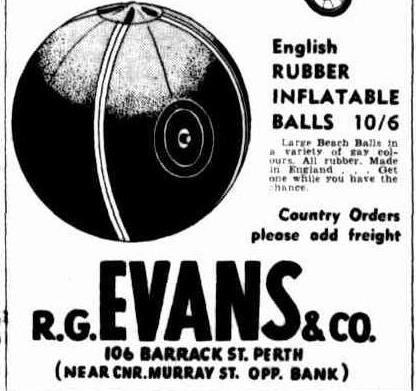 A modern Hamlet might well ask, "How long will a piece of plastic lie i' the earth ere it rot?" And the answer would be . . .Well, what would it be? Does anyone know, I wonder, just how long plastic buried in sand is likely to last?
A modern Hamlet might well ask, "How long will a piece of plastic lie i' the earth ere it rot?" And the answer would be . . .Well, what would it be? Does anyone know, I wonder, just how long plastic buried in sand is likely to last?
The only comforting thing is that the tons of plastic that are beginning to clutter up the beaches are less dangerous than the older forms of rubbish. You don't get splinters off it, and you can't gash yourself on it the way you can on rusty tins and empty beer bottles.
Still, I wish people would pick their bits of plastic up and take them home with them. It'll be a sad day when you have to take a bag of gardening tools with you when you go to the beach, so that you can sieve out all the (indestructible) plastic rubbish before you settle down in the sand. AT HOME with Margaret Sydney. (1965, April 21). The Australian Women's Weekly (1933 - 1982), p. 38. Retrieved from http://nla.gov.au/nla.news-article51397966
Advertisement with picture of English import (rubber inflatable): Advertising. (1948, November 18). The West Australian (Perth, WA : 1879 - 1954), p. 12. Retrieved from http://nla.gov.au/nla.news-article47143110
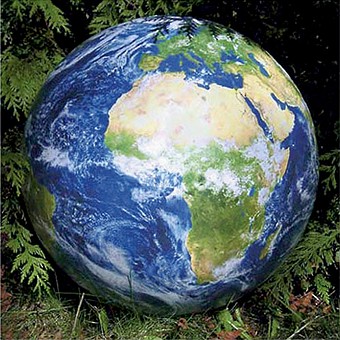 Today the ‘beach ball is made in all sizes from the oversized 2.75m in diameter, and colours, including versions that are blow up globes.
Today the ‘beach ball is made in all sizes from the oversized 2.75m in diameter, and colours, including versions that are blow up globes.
The largest inflatable beach ball is 15.82 (51ft 10 in) in diameter and was created by Real,- (Poland). It was presented and measured in Czluchow, Poland, on 8 May 2012. Apparently this beach ball looked like a football from the outside.
In July 2013 thousands of Scouts, Scouters and Venturers assembled in a light drizzle Sunday to attempt to set the Guinness World Record for “most people keeping beach balls in the air.” The current record, 14,993 people, was set in 2012, again in Spain. They did not succeed but they had a great time in the attempt, commenting in their report on the attempt:
It’s not a party until someone brings out a beach ball!
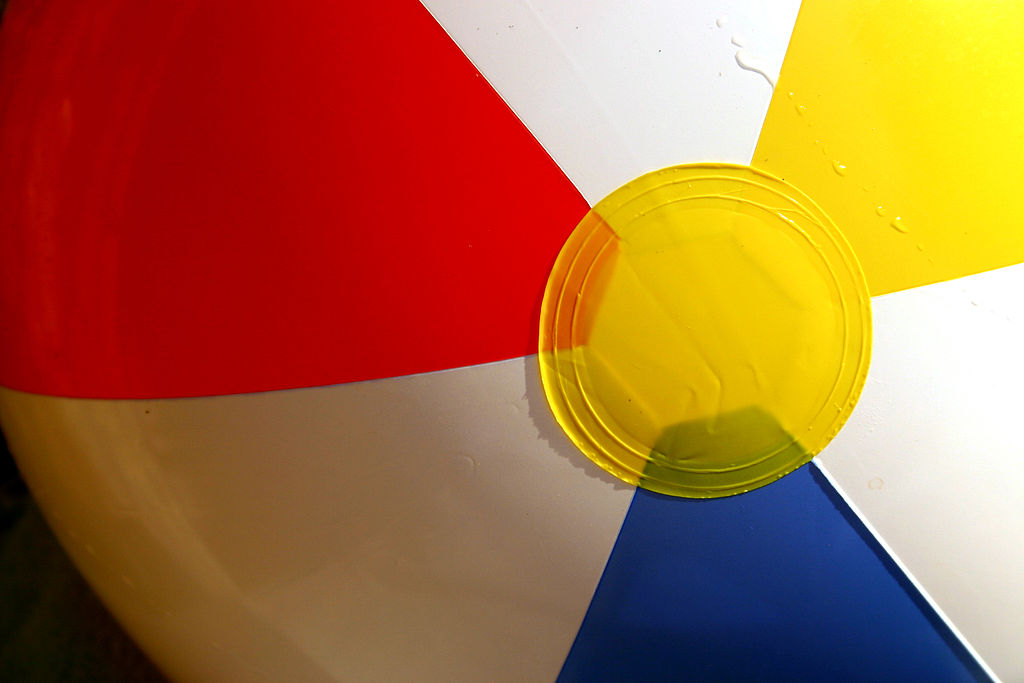
Researched by A J Guesdon. Copyright Pittwater Online News, 2013. All Rights Reserved.